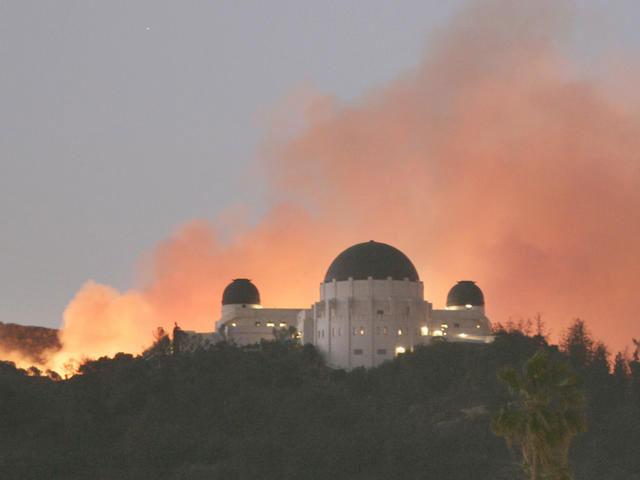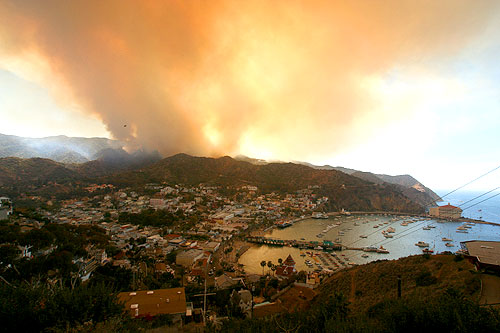May 10, 2007
Fire season is starting early this year, due to the drought! Right after they controlled the Griffith Park fire near the Los Angeles zoo and observatory — shown above — another fire forced people to evacuate the town of Avalon, on Catalina Island:
Luckily, neither caused any loss of life.
Today when I went out back I saw a rabbit, a ground squirrel, and a
baby ground squirrel all sitting near each other! I scared them all
away, because I don't like them eating our vegetables. The rabbit
ducked under a fence, the ground squirrel scurried up a wall, and the
baby scurried up afterwards... and fell back down! It tried again and
made it the second time. Just learning the ropes, I guess.
Squirrels are fairly rare here, at least compared to back east.
Instead of the Eastern gray
squirrel, S. carolinensis, we have the California
ground squirrel, S. beecheyi, which I've never yet warmed to
— perhaps because my first encounter with them was seeing the
holes they dug in our back yard. Maybe I should reconsider. They
have their fans, and
let's face it: they're cute.
Later I kept hearing a chirping sound out back — I hear it now,
too. It went on and on and on... I thought it was a bird, but I took
a look, and it was a ground squirrel: an adult, standing on a
cactus! Probably the same one. I think it was keeping tabs on the
baby, sort of telling it where home was.
I also saw a lot of baby goldfinches and thrushes today, drinking from
the fountain with their parents.
It's really spring!
I've been much more aware of finches ever since we bought a finch
sock feeder. They ate all the seeds in that — we need to
refill it — but now I see them around more, probably just
because I recognize them more easily.
Long-time readers of this diary may note that I've slacked off
talking about global warming precisely when all the news —
at least the US news — has gone wild talking about it all the
time. I guess I don't feel the need to be the canary in the coal
mine anymore. But, global warming is the big news story that just won't
quit. Here are a couple interesting items.
The oceans burped ... twice.
About 13,000 and 18,000 years ago, carbon dioxide poured into the
atmosphere in two giant belches that drove concentrations of the
greenhouse gas from 180 to 265 parts per million, where it held
relatively steady until the Industrial Revolution.
Scientists have long known about the jump in gas levels from looking
at ice cores. They suspected the carbon dioxide originated in a deep,
carbon-rich reservoir in the oceans but had no way to explain how the
gas could accumulate and then be released so suddenly.
Reporting in the journal Science today, researchers said they
found the answer in a sample of sediment drilled in the Pacific Ocean.
""This new study nails it," said
J.R.
Toggweiler, an oceanographer at
the National Oceanographic and Atmospheric Administration, who was not
involved in the study. "If there were any doubters, I don't think they
have a leg to stand on."
The researchers first correlated the bands of sediments in the core
drilled off Baja to the Greenland ice cores. That allowed them to
create a matching timeline over the last 38,000 years.
Embedded in the 50-foot-long Baja core were shells left by
bottom-dwelling microorganisms. The researchers analyzed the shells to
determine the ratio of two isotopes, carbon-12 and carbon-14.
Carbon-14 is produced by cosmic rays in the atmosphere. Thus, water
that stays deep in the oceans for thousands of years contains
relatively little carbon-14 and lots of carbon-12.
The researchers found two periods that stood out for low carbon-14 levels.
The levels meant that the water during those periods was barely
circulating to the surface. Carbon from decaying organic material was
accumulating in the deep. The old water eventually rose to the
surface, releasing its carbon dioxide in an enormous burp.
Each of the gas releases was recorded in the Greenland ice cores.
Thomas Marchitto,
a marine geologist at the University of Colorado at
Boulder and a lead author of the new study, said matching the rise of
old water to the atmospheric changes provides strong evidence that the
gas came from the ocean.
The burps injected 700 gigatons of carbon dioxide into the atmosphere
as Earth was already emerging from an ice age. What started the
warming is unknown, but scientists said the release of the gas
accelerated it.
Over a 10,000-year span, global temperatures rose by more than 7
degrees Fahrenheit.
Since the Industrial Revolution began in the mid-18th century, the
burning of fossil fuels has added 250 gigatons of carbon dioxide to
the atmosphere, raising the carbon dioxide concentration to 385 parts
per million and spurring a temperature increase of nearly 2 degrees.
Current emissions are 7 gigatons a year. About half of that is
absorbed by oceans.
One mystery about the burps remains: Where did they originate? The
sediment sample from Baja was merely a trace left as the old water
passed by on its way to the surface. "We still need to find the
original reservoir," Marchitto said.
And, most of all, I wonder where the CO2 came from!
Previous industrial civilizations?
The relevant paper is:
[...]
Colorado Springs, CO, is a boomtown in an arid region — just one
of many cities that rely for water on the melting snowpack of the
nearby mountains, delivered via the Colorado River and Arkansas River
watersheds. Many other cities get their water similarly from the
Sierra Nevada Mountains of California. But right now, the western
United States is facing a slow-motion water-supply catastrophe wrought
by climate changes that will inexorably reduce the snowpack. "The
western U.S. is really not in good shape at this point," says Linda
Mearns, a climatologist at the National Center for Atmospheric
Research (NCAR) in Boulder, CO, where she is director of the Institute
for the Study of Society and Environment. This has become fairly clear
"even without the regional detail" in climate models, she adds.
But the regional detail is still important for deciding how, where,
and when to respond. Consider the Homestake Reservoir. High in the
Rocky Mountains, not far from Vail, CO, it is part of a network of
reservoirs and pipelines that feed water to Colorado Springs. In June
2006, the reservoir filled at the unprecedented average rate of nearly
two feet per day. Because of higher temperatures earlier in the
season, the snowpack was melting more quickly than usual.
The unprecedented may become routine as global warming makes more
precipitation fall as rain, while what snow there is melts ever
faster. That's worrisome: a reservoir that fills more quickly than
expected can stress a dry levee. And there are other concerns. At what
point will earlier snowmelt translate into summer water shortages?
Will early spring torrents raise the risk of downstream flooding? Will
more-intense spring rainfalls increase sediment, overwhelming
filtration systems and washing more pollutants into the water supply?
And these climate-related questions arise at a time when rapid
population growth is already stressing water resources.
[...]
Two days after I saw the NCAR simulations, I visited
Ted
Scambos, lead
scientist at the University of Colorado's National Snow and Ice Data
Center (NSIDC)
in Boulder. Scambos studies ice dynamics to understand
the rate at which the ice sheets of Antarctica and Greenland are
responding to climate change. He and other scientists at NSIDC spend
their days poring over satellite data, studying how glaciers slide
down ancient hidden fjords and how warmer ocean water and the
glaciers' own meltwater lubricate their progress. "We are warming so
fast that the earth is still staggering backwards from the warming,"
Scambos said. "We may have already crossed the threshold of the last
warm period, a time when people were growing grain in Iceland and
raising dairy cattle in southeastern Greenland. And even if you
flattened out greenhouse emissions right now, my hunch is that all the
arctic sea ice in summer will eventually disappear."
"We're really, really in trouble," he continued. "It's just a question
of time. People say climate has changed before and people
adapted. That is true. But there weren't six billion of us, with all
the arable land working as hard as it could, and every one of those
areas counting on climate more or less staying the same. All our
infrastructure is built around this climate. Personally, I think we
have a strong moral obligation to respond in a fashion that gives
people a century from now a reasonable chance of making their way
ahead. We should do something."
The ability to "do something," however, depends on getting information
that is much better and more detailed. And that will depend on
increasingly precise computer models and more monitoring equipment to
feed data into those models. Not every city has a Goddard Institute
for Space Studies in its backyard, Cynthia Rosenzweig points out. She
says every local government should be given the tools to understand
how global warming will affect its community. "We need a national
capacity for scenarios, to provide every locality in the nation with
the input variables they need for projecting impacts and preparing
adaptations," she says. "We should begin to incorporate sea-level rise
into plans for coastal development. We should improve our responses to
heat waves — now — so we can be prepared for greater frequency and
duration. And we should consider the potential for more droughts — how
we would manage for more droughts and floods."
But from NASA to the NOAA to the National Science Foundation and the
U.S. Department of Energy, the budget picture is dismal. In 2005
dollars, the annual federal budget for climate-change research has
been slashed from more than $2 billion in the mid-1990s to less than
$1.6 billion today. Earlier this year, a National Academy of Sciences
report warned that Earth-observing satellites — basic hardware for
monitoring climate change — were at "great risk" of blinking
out. Without urgent investment, the report warned, 40 percent of
sensors and other instruments aboard NASA spacecraft could stop
functioning before the end of the decade. "At these agencies,
earth-science and climate — science budgets are either level or
decreasing in real dollars," says MIT's Ronald Prinn. "Under those
circumstances, what is needed for helping out states and cities is
just not going to appear. It is a sad state of affairs. At a time when
we should be trying to help at the regional to the local level, with
sound advice, we are facing this incapability to have accurate
forecasts at the local level that make the advice worth taking."
May 13, 2007
Right now we've got lots of roses blooming in the back yard, and the
bougainvillea, and verbena, and lavender... it's really nice. Our
enormous African basil, which seemed to die last summer, is gradually
growing back from the roots and becoming enormous again, with purplish
leaves and lots of fragrant purple flowers that the bees enjoy.
I wonder how sure they are that these CO2 burps came
"as the Earth was already emerging from an ice age".
I can imagine something like this causing the end of an ice age.
Ancient Eruptions of Carbon Dioxide Traced to Oceans
Researchers say the gas may have accelerated Earth's warming after an ice age.
Alan Zarembo, Los Angeles Times Staff Writer
May 11, 2007
![]()
and there's also a story to set it in perspective:
And here's another interesting story. Luckily, unlike the stories
above, you can read it for free online!
It shows people are taking climate change seriously — except
for the Bush administration. A few key quotes:
But while there's still uncertainty about the rate at which sea levels
are rising, it has become increasingly clear that temperature
increases alone could severely tax a large city's infrastructure. Late
last year, the Union of Concerned Scientists in Cambridge, MA,
released a report titled Climate Change in the U.S. Northeast.
Produced in collaboration with climate scientists, the report predicts
that by midcentury, northeastern cities could be experiencing an
average of 30 to 60 days of temperatures above 90°F (32°C)
each year, up
from 10 to 15 days historically. By the end of the century, these
cities could see 14 to 28 days of temperatures over 100ºF (38°C), if the
higher-emission scenarios are realized.
Last year NASA changed its mission statement, removing "to understand and protect
the Earth" from its list of objectives. Along with the National
Academy of Sciences, The American Association
for the Advancement of Science warns that climate monitoring satellites are in jeopardy
as spending shifts towards military and manned space flight programs.
While the US federal government plays ostrich, 31 states
joined forces on May 9th to form
The
Climate Registry: a system for collecting
"an accurate, complete, consistent, transparent and verified
set of greenhouse gas emissions data".
May 14, 2007
Lisa is back! She'd gone to a conference in Granada on Thursday the
3rd, stopping off to visit our friend Julie Strauss in Greenwich en route.
Now she's back. It's 12:30 am, and we had a little dinner... she's
pretty darn tired.
She left a booklet about the Alhambra on my side of the bed... I want to look at it! I'm really jealous, since I'm fascinated by Andalusia. Luckily, there's a good chance I'll go to Granada myself in the summer of 2008, since there some category theorists there have invited me to stop by before a conference on homotopy theory and higher categories in Barcelona. Lisa will probably come along and visit her colleague there.
After a good night's sleep...
My friend Chris Lee came to U. C. Riverside and gave a talk on "Mapping evolutionary pathways of HIV-1 drug resistance using conditional selection pressure". Very simply, the idea is to do statistical analyses of the HIV virus genome to see how it evolves. This virus mutates very rapidly, and develops resistance to all the drugs we throw at it. So, we need to understand the evolutionary pathways to design courses of treatment that don't just help it do better at evolving resistance. Luckily, there's enough data to do this now. Chris is using his knowledge of statistics to get the information out of this data:
- Lamei Chen and Christopher Lee, Distinguishing HIV-1 drug resistance, accessory, and viral fitness mutations using conditional selection pressure analysis of treated versus untreated patient samples, Biology Direct 1 (2006), 14.
May 18, 2007
What should we do about climate change? Read what some experts have to say:- Marilyn Berlin Snell, Climate exchange: cool heads tackle our hottest issue, Sierra, May/June 2007.





